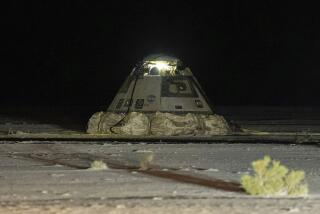SpaceX confirms testing ‘anomaly’ destroyed Crew Dragon capsule
- Share via
A SpaceX Crew Dragon astronaut capsule was destroyed in an accident during testing last month in Florida, a company executive confirmed Thursday morning.
Hans Koenigsmann, SpaceX vice president of build and flight reliability, told reporters that initial data indicate the accident occurred during activation of the capsule’s SuperDraco escape system thrusters. He said the April 20 incident — which, as seen in a leaked video, involved an explosion and which SpaceX and NASA have described as an “anomaly” — occurred half a second before the SuperDraco thrusters were scheduled to fire.
Koenigsmann said that there was no reason to believe the problem was with the SuperDracos — which he said have been tested about 600 times — and that SpaceX continues to have “high confidence in that particular thruster.” A SpaceX-led investigation into the incident is ongoing, with NASA’s participation. There were no injuries.
“We do need to still collect evidence. We need to make sure we don’t miss anything,” Koenigsmann told reporters Thursday during a news conference held to discuss SpaceX’s upcoming launch of its cargo Dragon capsule to the International Space Station, scheduled for Friday morning. “I believe what we learn from this test will make us basically a better company, and Dragon 2, at the end, a better vehicle, a safer vehicle.”
The cargo Dragon capsule is a different vehicle from the Crew Dragon and does not have the SuperDraco escape thrusters. The capsule scheduled to fly Friday was used for a NASA cargo mission two years ago.
The Crew Dragon capsule is intended to carry NASA astronauts to the space station. In 2014, Hawthorne-based SpaceX and Chicago-based Boeing Co. each won NASA contracts worth a combined total of $6.8 billion to build crew capsules.
In March, SpaceX — which is led by Elon Musk — completed its first demonstration flight of the now-destroyed capsule to the space station. With no crew aboard, the Crew Dragon docked autonomously with the station and then returned to Earth. The capsule was set to be reused in an in-flight abort test next month, in which it would be launched on a rocket and detached prematurely to ensure its escape system works. A crewed flight test had been set for later this year.
Koenigsmann said he hoped SpaceX could launch astronauts in Crew Dragon by year’s end, but the timeline would partly depend on the investigation’s outcome. He said the SuperDracos were not used during the March demonstration mission.
On April 20, SpaceX was conducting a series of engine tests on the Crew Dragon test capsule. Those included two separate, five-second firings of the capsule’s Draco thrusters, which are smaller and help the craft maneuver in space. The final test — which was derailed by the “anomaly” — was supposed to involve firing the capsule escape system’s eight SuperDraco engines.
Afterward, a cloud of orange smoke was seen rising above Cape Canaveral Air Force Station, where the test occurred. Experts have said the color probably was due to the presence of nitrogen tetroxide — one of the two propellants that power the capsule’s escape systems. When combined, the two propellants immediately ignite.
Koenigsmann did not specify the cause of the problem, saying Thursday that the investigation is still in its early stages.
More to Read
Inside the business of entertainment
The Wide Shot brings you news, analysis and insights on everything from streaming wars to production — and what it all means for the future.
You may occasionally receive promotional content from the Los Angeles Times.











